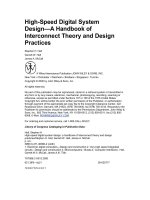Organization theory and design: Lecture 16
Bạn đang xem bản rút gọn của tài liệu. Xem và tải ngay bản đầy đủ của tài liệu tại đây (41 KB, 13 trang )
16
Framework
Uses Two Elements:
1. Variety:
–
1.
Task variety, frequency of unexpected and novel events that
occur in the conversion process, if they are high Variety is
high
Analyzability:
–
–
–
–
When the process is analyzable, the work can be reduced to
mechanical steps and participants can follow a set pattern to
solve problems.
The reference for solutions is SOPs, manuals, text books, etc.
Not so if the problem has low analyzability
Here the reference for solution is much less explicit and lies in
implicit or tacit transfer of knowledge which is built through
accumulated experiences.
1
Framework
1. High Analyzability /Low Variety – Routine
Technologies:
• sales, clerical, drafting, auditing
1. High Analyzability /High Variety – Engineering
technologies:
• legal, engineering, accounting
1. Low Analyzability /Low Variety – Craft:
• performing arts, trades, general management, college
teaching
1. Low Analyzability /High Variety – Non Routine:
• strategic planning, social science research, applied
research, university teaching
2
Departmental Design
Routine Technologies
1. High formalization
2. High centralization
3. Little training or experience
4. Wide span of control
5. Vertical, written communication
6. Overall design - Mechanistic
3
Departmental Design
Engineering Technologies
1. Moderate formalization
2. Moderate centralization
3. Formal training
4. Moderate span of control
5. Written and verbal communication
6. Overall design - towards Mechanistic
4
Departmental Design
Craft Technologies
• Moderate formalization
• Moderate centralization
• Work experience
• Moderate to wide span
• Horizontal, verbal communication
• Overall design - towards Organic
5
Departmental Design
Non Routine Technologies
• Low formalization
• Low centralization
• Training plus experience
• Moderate to narrow span
• Horizontal communication, meetings
• Overall design - Organic
6
Workflow Interdependence
Among Departments
• Interdependence means the extent to
which departments depend on each other
for resources or materials to accomplish
their tasks.
• Low interdependence means that
departments can do their work
independently with consultation,
interaction, or exchange of materials.
• High interdependence means departments
must constantly exchange resources.
7
Types of Interdependence
1. Pooled:
•
It is the lowest form of interdependence,
work does not flow between units, example
of relationships in a Divisional structure, a
fast food chain having many branches is
also an example. Departments should use
standardized rules and SOPs so that
activities across departments are
standardized.
8
Types of Interdependence
2. Sequential:
•
The serial form of interdependence, with parts
produced in one department become inputs to
another department, this is higher level of
interdependence than pooled, because departments
exchange resources and depend upon others to
perform well, greater need for horizontal
mechanisms such as integrators or task forces,
since this interdependence implies a one-way flow
of materials, extensive planning and scheduling are
generally needed.
9
Types of Interdependence
3. Reciprocal:
•
Highest level of interdependence, output of
operation A is the input to operation B, and the output of
operation B is the input back again to operation A,
hospital is an excellent example, a patient may move
back and forth between X ray, Surgery and
Physiotherapy as needed, a firm developing new
products is another example, intense coordination would
be required between design, engineering, manufacturing,
and marketing, a coordinated horizontal structure is
required, daily face-to-face interaction between
managers, teamwork are required.
10
Relationships Among
Interdependence of Team Play
Cricket
Interdependence Pooled
Football
Basketball
Sequential
Reciprocal
Physical
dispersion of
players
High
Medium
Low
Coordination
Rules
Game plan
Adjustment
Key
management
challenges
Develop
skills
Prepare &
execute game
plan
Influence flow of
the game
11
Impact of Technology on Job
Design
Job Design:
• the assigned goals and tasks to be accomplished by the employees,
changes in job design can influence motivation and performance of
the employees
• for example, consider a job which is boring, management can
introduce job rotation to reduce boredom
• research indicates that mass production technologies tend to
produce job simplification (variety of tasks reduced)
• more advanced technologies tend to cause job enrichment
• advanced technologies can also contribute to job enlargement
(expansion of the different tasks performed by an employee)
12
Sociotechnical Systems
• This approach recognizes the interaction of technical and
human needs in effective job design.
• Social system includes all human elements – individual
and team behavior, culture, management practices, and
degree of communication openness.
• Technical system refers to the type of production
technology, the level of interdependence, the complexity
of tasks
• The goal of this approach is to design the organization
for joint optimization, which means that an organization
functions best only when the social and technical
systems are designed to fit the needs of one another
13









